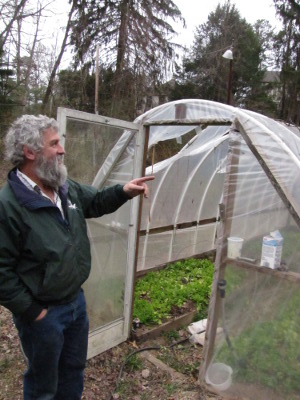
Combining forest gardens and vegetable gardens

Whenever I tell people
about forest gardening, the inevitable reply is "You really expect to
grow all of your food with perennials?" I'm quick to set them
right, explaining that we definitely plan to keep growing our
delectable tomatoes, broccoli, and other row crops. Forest
gardening and traditional annual gardens work well together --- you can
set aside the best land for your vegetable garden and put your forest
garden on the sloping hillside that would wash away if you tilled it or
down in the swamp where you'd never be able to plow. You can also
plant traditional vegetables amid your forest garden plants in sunny
gaps (especially as your perennials are slowly filling out.)
Alice and Dudley mixed and matched annuals and perennials very
elegantly in their city backyard.

Since trees run along
the south side of their property, they take advantage of that partial
shade to plant their forest garden crops. Real shade lovers like
nettles, currants, and elderberries gradually give way to trees and
shrubs that need full sun. In a gap in the forest garden, Alice
had built a beautiful raised bed out of colored bottles and planted it
with garlic.
Meanwhile, Dudley had
selected the sunniest spot near the north side of the yard for growing
tomatoes and lettuce in his homemade greenhouse. You can read
about how he made this 20 foot long greenhouse for about $300 in just a
few hours on his website. You might notice in
this photo that the plastic is tearing --- Dudley explained that the
greenhouse covering is finally starting to get too brittle to repair
after five years and will need a new sheet of plastic.
I hope that Alice and
Dudley's garden will inspire some of you to take a look at your own
growing space and mix and match your annuals and perennials.
| This post is part of our Real Forest Gardening lunchtime series.
Read all of the entries: |
Want more in-depth information? Browse through our books.
Or explore more posts by date or by subject.
About us: Anna Hess and Mark Hamilton spent over a decade living self-sufficiently in the mountains of Virginia before moving north to start over from scratch in the foothills of Ohio. They've experimented with permaculture, no-till gardening, trailersteading, home-based microbusinesses and much more, writing about their adventures in both blogs and books.
Want to be notified when new comments are posted on this page? Click on the RSS button after you add a comment to subscribe to the comment feed, or simply check the box beside "email replies to me" while writing your comment.
- Remove comment
- Remove comment
